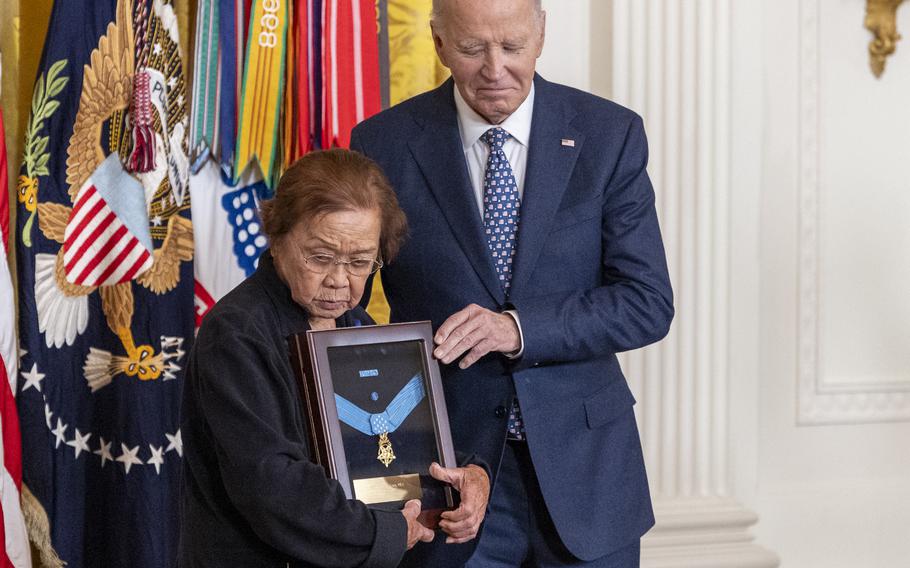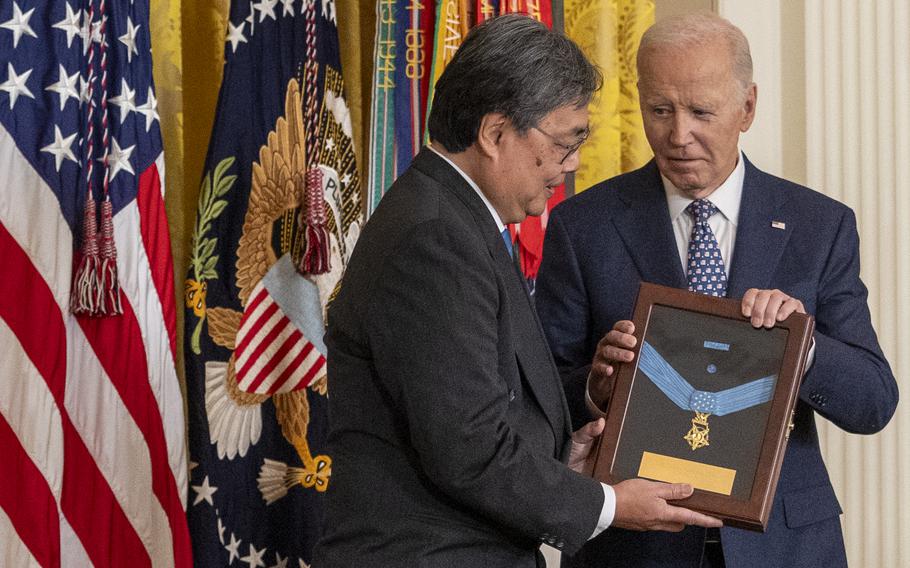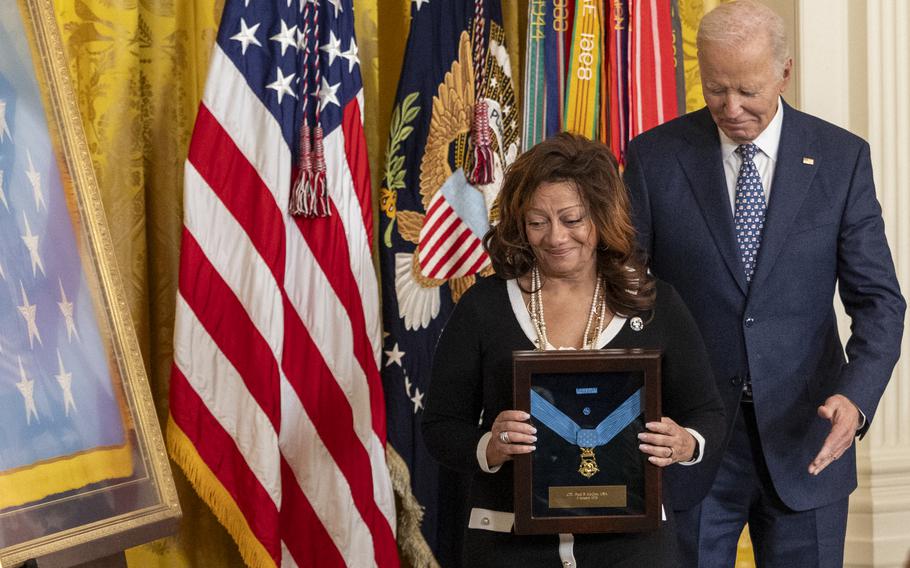.jpg/alternates/LANDSCAPE_910/20250103_Medal_of_Honor_0272%201.jpg)
President Joe Biden smiles with Juanita Mendez at a White House ceremony on Jan. 3, 2025, during which her brother Pfc. Charles R. Johnson was posthumously awarded the Medal of Honor. (Eric Kayne/Stars and Stripes)
WASHINGTON — Juanita Mendez gave President Joe Biden a kiss as she sat on stage Friday to accept the nation’s highest military honor for combat valor on behalf of her brother, Pfc. Charles Johnson.
It drew a laugh from the crowd gathered in the East Room at the White House. Biden didn’t seem to mind the moment but moved forward with presenting the Medal of Honor to five Korean War soldiers.
“These are genuine to their core heroes. Heroes of different ranks, different positions and even different generations,” he said during the ceremony. “But heroes who all went above and beyond the call of duty, heroes who all deserve our nation’s highest and oldest military recognition.”
The president presented seven medals Friday to soldiers who served in the Korean War and Vietnam War. The heroics of the five troops who fought in Korea were not fully recognized at the time, and they received the Medal of Honor posthumously as part of a campaign to shine a light on the role of minority service members in defense of the United States.
All five — one Hispanic, one Filipino-American, one Japanese-American and two African-Americans — were awarded medals for valor at the time.
Top row, from left: Pvt. Bruno Orig, Richard Cavazos, Pfc. Charles Johnson. Bottom row, from left: Cpl. Fred McGee and Pfc. Wataru Nakamura. (U.S. Army)
However, in August 2021, Defense Secretary Lloyd Austin directed secretaries of the military branches to review decorations given to Black and Native American veterans to determine whether their actions “warrant the award of the Medal of Honor,” the military’s highest award for valor.
Of the more than 3,500 service members who have been awarded the Medal of Honor, only 94 African-Americans, 59 Hispanic and 35 Asian or Pacific Islanders have received the decoration, according to the Congressional Medal of Honor Society.
On Friday, Biden added five more.
Cavazos, who was from Kingsville, Texas, entered the Army after graduating from what is now Texas Tech University. During the Korean conflict, he served as commander of E Company, 2nd Battalion, 65th Infantry Regiment, comprised mostly of Spanish-speaking Puerto Ricans.
On the night of June 14, 1953, Cavazos led his company on a raid on an enemy outpost on Hill 142 near Sagimak, Korea. During the initial attack, the company came under intense mortar and artillery fire.
After fierce close combat in the enemy trenches, the company was forced to pull back under heavy artillery and mortar fire. Twice more Cavazos led his soldiers in assaults on the position despite intense hostile fire.
.jpg/alternates/LANDSCAPE_910/20250103_Medal_of_Honor_0331%201.jpg)
President Joe Biden stands next to Laura Blevins after posthumously awarding the Medal of Honor to her father, retired Gen. Richard E. Cavazos, on Jan. 3, 2025, in Washington. (Eric Kayne/Stars and Stripes)
Ordered to withdraw, Cavazos remained alone on the enemy position to search for missing men. While exposed to enemy fire, he located five casualties and evacuated them to safety on the reverse slope of a nearby hill where they were shielded from enemy fire.
Returning to the battlefield, he found others who had become separated from the main assault force and personally led them to safety.
Cavazos repeatedly returned to the enemy position until he was satisfied all had been accounted for, according to records from the time. Only then would he allow medics to treat his own wounds.
Cavazos was initially awarded the Distinguished Service Cross, the second-highest military decoration for valor, for his actions on Hill 142.
After fighting in Korea ended, Cavazos remained in the Army and was again awarded a Distinguished Service Cross for gallantry in Vietnam. In 1976, he became the first Hispanic to be promoted to brigadier general and six years later was appointed the first four-star general of Hispanic origin.
He retired in 1984 after a 33-year career and died in 2017 at age 88. In 2023, Fort Hood, Texas, was renamed Fort Cavazos after Congress directed the removal of names of Confederates from American military installations.
Cavazos’ son Tommy said he isn’t certain that his father would accept the Medal of Honor if he were still living because “it was something my dad never sought or pursued or felt that he was entitled to.”
Instead, his father felt bad “because he knew he couldn’t get everybody off that field. And I think he always was haunted by that.”
Pvt. Orig was born in Hawaii to parents from the Philippines. He was 11 years old when the Japanese attacked Pearl Harbor in 1941, plunging the U.S. into World War II. Following the example of his father and stepfather, he enlisted in the Army in 1950 less than two months after the North Koreans attacked the South, igniting the Korean War.
On Feb. 15, 1951, while assigned to G Company, 2nd Battalion, 23rd Infantry Regiment, Orig was returning from a wire-laying mission near Chipyong-ni, Korea, when he saw several of his comrades had been wounded during an attack.
Disregarding his own safety, Orig rushed to them and began administering first aid under fire. With the help of several comrades from the company command post, Orig began removing the wounded to safety.

President Joe Biden stands next to Loretta Orig after posthumously awarding the Medal of Honor to her brother Pvt. Bruno R. Orig on Jan. 3, 2025. (Eric Kayne/Stars and Stripes)
After returning to help more of the wounded, Orig volunteered to man a machine gun because most of the crew had been wounded. He provided covering fire so a platoon of allies could escape and continued firing even as his company’s positions were overrun.
After the battle was over and the area secured, Orig was found dead beside his weapon. In front of his position lay the bodies of several enemy soldiers.
He was 20 years old. For his sacrifice, he was initially awarded the Distinguished Service Cross.
“He came upon a firefight, rescued fellow soldiers, took a machine gun position, engaged with the enemy and ultimately died in action,” his nephew Charles “Chuck” Allen III said. “But [he] saved a platoon and doing that is now being recognized.”
Biden described what Orig did as “being the definition of valor.”
Orig’s sister, Loretta, accepted the award on his behalf. Biden put his arm around her as the Medal of Honor citation was read. She wiped away a tear before Biden handed the framed award to her.
Pfc. Nakamura was a 20-year-old Japanese-American when the U.S. entered World War II and then-President Franklin Roosevelt ordered citizens of Japanese descent into internment camps. Nakamura and his family were sent to a camp in Rowher, Ark.
“But still, he signed up to serve our nation during World War II and the Korean War,” Biden said.
After Japanese-American men were allowed to enlist, he signed up for the Army, according to his nephew Gary Takashima. He was assigned to the 442nd Regimental Combat Team, a Japanese-American unit that fought in Italy and became one of the most decorated American units of the war.

President Joe Biden stands next to Gary Takashima after posthumously awarding the Medal of Honor to his uncle, Pfc. Wataru Nakamura, on Jan. 3, 2025, in Washington. (Eric Kayne/Stars and Stripes)
After World War II, Nakamura joined the Army Reserve and was called up when the Korean War began. On May 18, 1951, Nakamura, serving as a lieutenant in the 2nd Infantry Division, volunteered to repair a communications line between his platoon and the command post. As he made his way along the line, he came under fire from an enemy unit threatening to breach the company defense lines.
Nakamura rushed the enemy troops with a fixed bayonet and singlehandedly destroyed a hostile machine gun position, driving the enemy from several bunkers they had captured. When his ammunition ran low, he withdrew under intense enemy fire until he met an ammunition party climbing the hill.
With more ammunition, Nakamura returned to the fight, killing three enemy soldiers in one bunker before charging another. Continuing to press the attack, he was mortally wounded by an enemy grenade.
Nakamura was 29. He initially received the Distinguished Service Cross for his actions and sacrifice.
“He lost his life, volunteering for an assignment, helping out his unit,” Takashima said. “My uncle had a commitment to his service and his fellow soldiers. It impressed one of his buddies, Richard Edlebeck. When Richard learned years later his friend didn’t receive the Medal of Honor, he spent the rest of his life working on a packet.”
Takashima said his uncle would have been honored to receive the award but “felt all of this was too much for doing what he was supposed to do.”
Cpl. McGee was an African-American from Steubenville, Ohio, who enlisted in the Army in May 1951, only about three years after then-President Harry S. Truman ordered the desegregation of the U.S. military.
Biden said McGee served in one of the first integrated Army units in the Korean War.
Sent to Korea, McGee was serving with the 7th Infantry Division on Hill 528 when his unit came under fire. After his squad leader was wounded, McGee assumed command and ordered the remaining members to advance to a more exposed position and attack an enemy machine gun crew.
When his own machine gunner was mortally wounded, McGee took over the weapon and ordered the rest of his squad to withdraw while he provided cover fire.

President Joe Biden stands next to Victoria Secrest after posthumously awarding the Medal of Honor to her father, Cpl. Fred B. McGee, on Jan. 3, 2025, in Washington. (Eric Kayne/Stars and Stripes)
Though wounded in the face, he stood straight up under intense enemy machine gun and mortar fire and tried to evacuate the body of the company runner. Forced to abandon the body, he aided a wounded man and moved him to safety through a barrage of enemy mortar and artillery fire.
McGee’s daughter, Victoria Secrest, said while her father was still in Korea, a comic book publisher wanted to do a story on his actions at Hill 528. However, there was a glaring inaccuracy in the depiction.
“They made him a white soldier,” Secrest said. “I think it could have been inadvertent because they hadn’t seen a picture of him. I don’t know if they ever saw his DD-214 (service record).”
McGee was initially awarded a Silver Star, the third-highest combat decoration. He died in 2020.
“When I hear about his acts of valor on the battlefield, it comes as no surprise because he was always selfless, loving and honorable in everything he did,” said Kristen Lee Bailey, his granddaughter.
Before Pfc. Johnson was drafted into the Army, he played football, basketball, baseball and ran track at Arlington High School in New York. He was also a singer.
Biden said, according to one of Johnson’s high school classmates, “he was a heck of a football player.”
“He had some options when he was drafted,” said his nephew Garry Trey Mendez. “He could have applied for different roles in the military. But he said, ‘No, if other people are going to the front, I need to go to the front too.’ ”
Johnson, who was African-American, was serving as a Browning Automatic Rifle operator with Company B, 15th Infantry Regiment, 3rd Infantry Division, when Chinese forces attacked his unit on June 11-12, 1953. Overwhelming numbers of Chinese troops assaulted the trenches and bunkers defended by Johnson and his squad.
Johnson, who was wounded by artillery and grenade fire, administered first aid to the more seriously injured. He dragged a wounded soldier to a secure bunker, stopping intermittently to aid injured soldiers and kill several enemy troops in hand-to-hand combat.
As the second bunker came under attack, he left the position and began firing at the enemy to defend the American wounded. He was killed in the fighting at age 20. Mendez said his uncle saved the lives of at least eight soldiers, including his high school classmate Don Dingee.
He was posthumously awarded the Silver Star in 2010.
Mendez credits his mother, Juanita, for pressing the Defense Department to upgrade his award to the Medal of Honor, while acknowledging Dingee for sharing the story and Arlington High School’s support through the years.
When Biden handed Juanita Mendez her brother’s framed Medal of Honor, she took a few seconds to look it over. She turned the medal around proudly for the crowd of a few hundred to see before returning to her seat.